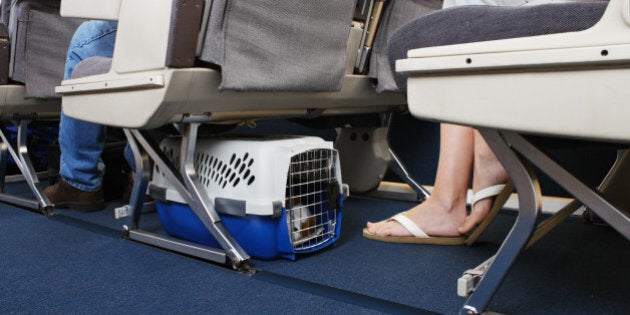
Flying with your pet can be a stressful experience. Not only because of the rules, regulations and requirements, but also because us pet lovers know that flying can be hard on our fur babies. If you are planning on flying with your pet, here are some things you should know:
Every airline is different when it comes to if and how pets travel. Where your pet is placed on the plane (the cabin or the cargo hold) also depends on the size of the animal. In addition to carry-on sized pets, service and emotional support animals are also allowed in most aircraft cabins, however, you'll need them to be certified as such.
If you are planning to carry-on your small animal be aware that most airlines only allow a certain number of pets in the cabin. Make sure you call ahead and see if you are able to bring your pet on-board. The cost of bringing your pet varies from about $100 to $500 depending on the airline.
Unfortunately, if you have a dog with a short snout you might not be able to fly with them at all. Certain airlines restrict dogs such as boxers, pugs, Shih Tzu, King Charles Spaniels and others because they have a higher chance of dying in the cargo hold due to respiratory issues related to a snub-nose. So to keep things consistent they are banned from the aircrafts entirely.
Before booking any flights, make sure your pet is healthy enough to fly. Underlying or pre-existing conditions make up the majority of incident reports so make sure you get your vet to clear your pet for air travel. Opt for a direct flight whenever possible; the shorter the journey the better.
When picking a pet carrier make sure that it is double the width of your dog and is tall enough so they can stand up comfortably in it. If they are flying in the cargo hold, a water and food dish should be attached to the inside of the door and a "live animal" sticker should be on the top of the carrier. Make sure your name, flight info, pet's description, name and photo is taped to the outside of the pet carrier in case your animal escapes. Be sure your pet gets plenty of exercise the day before and day of travel, a tired pet travels in a carrier better than a jumpy one. And it might be tough but try not to feed your pet for at least four to six hours before your flight. This will help prevent any accidents in the air.
Finally, whatever you do, don't try to sedate your pet. The risks far outweigh any potential benefits as you don't know how your pet will react, especially 30,000 feet in the air. When in doubt, my advice is to leave your furry friend at home with a trusted care giver.
I hope these tips help you and your pet have safe and happy flight the next time you travel!
Follow HuffPost Canada Blogs on Facebook